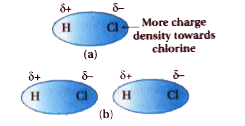Explain Dipole - Dipole forces snd its characteristics ? Solution in Gujrati
Dipole - Dipole forces : Dipole - dipole forces act between the molecules possessing permanent dipole. e.g. forms dipole dipole forces.
Ends of the dipoles possess ..Partial charges.. and these charges are shown by Greek letter delta . Partial charges are always less than the unit electronic charge .
Formation of Dipole - Dipole forces : Neighbouring polar molecules interact with each other.

e.g. : The polar molecules interact with neighbouring molecules. Figure shows electron cloud distribution in the dipole of hydrogen chloride and Fighure shows dipole - dipole interaction between two HCl molecules.
Characteristics :
This interaction is stronger than the London forces but is weaker than ion - ion interaction because only partial charges are involved.
The attractive force decreases with the increase of distance between the dipoles.
As in the above case here also, the interaction energy is inversely proportional to distance between polar molecules.
Dipole - dipole interaction energy between stationary polar molecules (as in solids) is proportional to and that between rotating polar molecules is proportional to , where r is the distance between polar molecules.
Note : Besides dipole - dipole interaction, polar molecules can interact by London forces also. Thus cumulative effect is that the total of intermolecular forces in polar molecules increase.
Topper's Solved these Questions
- BOOK - KUMAR PRAKASHANCHAPTER - STATES OF MATTER EXERCISE - SECTION - A QUESTIONS (Sub Question)3videos
STATES OF MATTER
- BOOK - KUMAR PRAKASHANCHAPTER - STATES OF MATTER EXERCISE - SECTION - A QUESTIONS (TRY YOUR SELF)47videos
STATES OF MATTER
- BOOK - KUMAR PRAKASHANCHAPTER - SOME BASIC CONCEPTS OF CHEMISTRYEXERCISE - Section - D (Solutions of NCERT Exemplar Problems) (Long Answer Type Questions)4videos
SOME BASIC CONCEPTS OF CHEMISTRY
- BOOK - KUMAR PRAKASHANCHAPTER - STRUCTURE OF ATOMEXERCISE - QUESTINS PAPER FROM MODULE (SECTION -D)2videos
STRUCTURE OF ATOM
Similar Questions
Derive Boyle.s formula according to his law.
06:49View SolutionAt 300 K constant temperature gas having 20cm3, 1 bar pressure it is convert into 50cm3 then calculated pressure ?
05:15View SolutionA vessel contains 1.6 g of dioxygen at STP (273.15 K, 1 atm pressure). The gas is now transferred to another vessel at constant temperature, where pressure becomes half of the original pressure. Calculate
(A) volume of the new vessel.
(B) number of molecules of dioxygen.02:30View SolutionExplain Heisenberg’s uncertainty principle.
02:45View SolutionDIPOLE-DIPOLE FORCES AND DIPOLE-INDUCED DIPOLE FORCES
02:45View SolutionDIPOLE-INDUCED DIPOLE FORCES
00:46View SolutionDipole-dipole, dipole-induced dipole and dispersion forces are collectively called as …………………………….
06:45View SolutionBriefly explain dipole-induced-dipole interaction with example.
01:59View SolutionBriefly explain dipole-induced-dipole interaction with example.
05:01View SolutionThe energy order of dipole-dipole forces is'
04:12View SolutionThe term Vander Waals forces refers to
A) Dipole -- dipole interaction B) Dipole - induced dipole
C) Dispersion forces04:29View SolutionExplain induced dipole-dipole attractions.Give examples.
03:00View SolutionExplain Dipole - Dipole forces snd its characteristics ?
02:17View SolutionExplain Dipole - induced dipole forces.
02:15View SolutionWhat is Dipole - induced dipole forces ? Give its characteristic.
53:29View Solution

